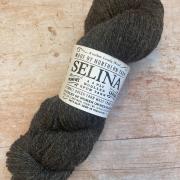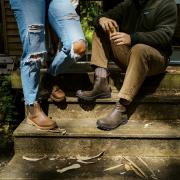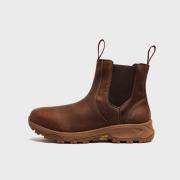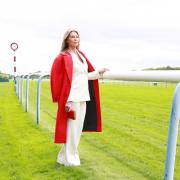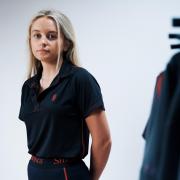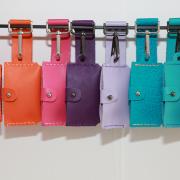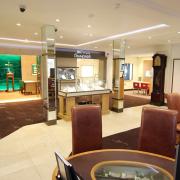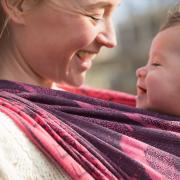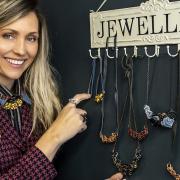Not so long ago sheep farmers were burning fleeces because the price was so low. Now there’s a revival, writes Mike Glover.

A SPECIAL breed of passionate and creative people is striving to ensure one of the icons of the Lake District survives to help preserve the landscape beloved of artists and 17 million visitors a year.
Roughly 95% of Herwicks live within 14 miles of Coniston, with substantial numbers in the Duddon Valley and on the fells west of Windermere. Famously, Beatrix Potter made it a condition of her gift of 15 farms to the National Trust that flocks of her beloved Herdwicks would be maintained in perpetuity.
But the breed hasn’t had an easy time. Keeping Herdwicks became increasingly unviable and fleeces dropped as low as one penny per kilogram at auction. Privately, many farmers confess to having burned them and shearing only continued for animal welfare reasons.
But here are signs the tide has turned. John Barraclough says he is paying twice as much for yarn now as he was when he started his business Wools of Cumbria Carpets five years ago.
Demand is growing, his order books are buoyant and all the spinners, weavers and mills that survived the bad years are finding themselves busy.
‘There’s still a way to go, but the tide is definitely turning,’ said John, who moved house and headquarters to a farm near Sedbergh just over a year ago. He had been a spinner running a family business for 40 years before that.
He puts the revival down to a number of factors. First the colour grey became fashionable in home design although any colour is available for larger orders. Secondly, the upland wools from Herdwick, Swaledale and Rough Fell are in tune with the growing desire to use natural, sustainable and ecologically sound products. Finally, there are health factors. Many carpets and furnishings contain chemicals causing allergies.
Because these upland sheep based products are pure and natural, with jute and hessian backing, they don’t spark allergic reactions. ‘I have even had customers taking samples home to sleep with to ensure they are not allergic to them,’ said John.

It is the very qualities of the wool that gives the Herdwicks their hardiness and ability to survive Lakes winters that had made it unfashionable. The fibres were deemed too thick, coarse and wiry.
Yet when he re-engineered his looms to make Herdwick carpets for others like the National Trust and Goodacres, they were amazed how suited the wool was.
Now John sells carpets directly to customers all over Europe and America as well as Britain. The yarn is spun in Huddersfield and woven into carpets by Jorgus Carpets of Chorley and Cavalier Carpets of Blackburn.
Fleece for fashion
Clothing could certainly provide Herdwick wool with a future. Shepherdess Alsion O’Neill is aiming to revive the “coat of grey” in the song D’ye Ken John Peel by producing Herdwick tweed. The initiative has been inspired by the world-wide success of Harris Tweed and is already exciting those in the fashion world who want natural, sustainable materials that stand the test of time.
A few years ago she went to the Outer Hebrides to see where tweed was made and befriended Donald John Mackay, MBE, probably the most famous weaver in the world.
She started buying rolls of Harris Tweed cloth to bring back to be made into jackets, waistcoats and three styles of skirts by Lakeland Skirts in Kendal. ‘I was discussing tweed with Mr Mackay, and he said “Have you not got tweed in Cumbria?” Even though the county has more sheep than anywhere else in Britain, the answer was no.’

Alison started using Herdwick, Rough Fell and Swaledale wools, woven on looms in Huddersfield. But the solution to creating a Cumbrian Tweed was only a few miles from her home.
Also in Sedbergh is Farfield Mill which was saved 12 years ago as a heritage centre, including two Victorian Dobcross Looms which had been due to be dismantled.
They were made between 1861 and 1970 by Hutchinson & Hollingworth of Diggle, Saddleworth. Many were exported across the world and are still found working in far-flung places, but to see these looms in action today is an uncommon experience in the United Kingdom.
Master weaver David McDowell operates it for weekend demonstrations, making rugs and once blazers for Ampleforth College students.
The mill team is delighted to take on orders from Alison to create a Cumbrian Tweed, with the first batch due this spring.
‘We are happy to do it and our prices will be competitive. We are just waiting for the orders to roll in,’ said centre manager Sara Last.
Alison says that she is already getting more orders for her clothes made from Herdwick wool than Harris Tweed. ‘People seem to like the Herdwick wool for its beauty and its tough and wild spirit - just like the sheep.’

Woolly thoughts
John Barraclough’s campaign to revive Herdwick, Swaledale and Rough Fell had an early convert in rug maker Jane Exley, who set up her business, The Woolly Rug Company, in Ambleside, 16 years ago.
‘Herdwicks provide naturally grey wool with a variety of fibres. This irregularity of tone gives it character and a compatibility with a range of natural organic flooring, whether wood or slate,’ she said. ‘The wool dyes well. Despite some people thinking that the irregular tone is out of fashion, I was determined to prove them wrong. It is also hard wearing, so when you buy a Herdwick rug you buy a product for life, not a part-time commodity.
‘We need to force manufacturers to use better quality materials and shove planned obsolescence off the table, as that doesn’t do sustainability or the environment any good.’
She makes bespoke rugs after interviewing customers and seeing where they want it to sit. She then creates a design which is put on a stretched canvas before firing plain and dyed yarns out of a hand-tufting gun driven by compressed air. The result is a unique rug, of which she has made around 1,000 since starting out.
So apart from carpets, what else is Herdwick wool good for? Other uses have been tried: as insulation for walls or as underlay for stone footpaths, but neither is likely to make the fleeces profitable.
Former Lancashire farmer Walter Lloyd, now aged 90, has been demonstrating how to make rope out of Herdwick. As a former naval man, he had learned to make ropes out of all sorts of materials.
He moved from the Whitworth Valley north of Rochdale, to help revive the coppicing industry in the Lake District. It was while making charcoal in Cartmel back in the 1980s that he developed the idea of making rope out of Herdwick carpet yarn.
‘It has the strength of plastic but naturally stretches, making it ideal for dog leads and when used for towing it allows the pulled vehicle to glide away instead of jerking,’ he said.




